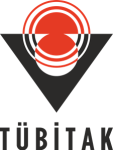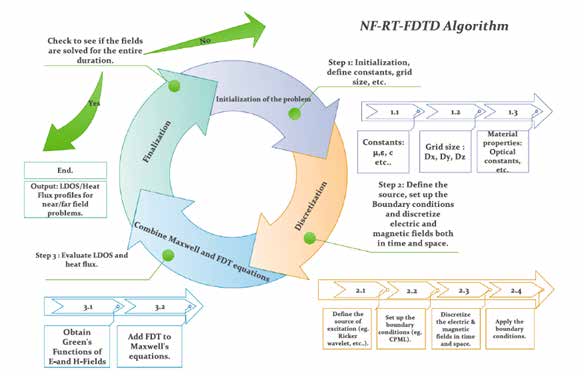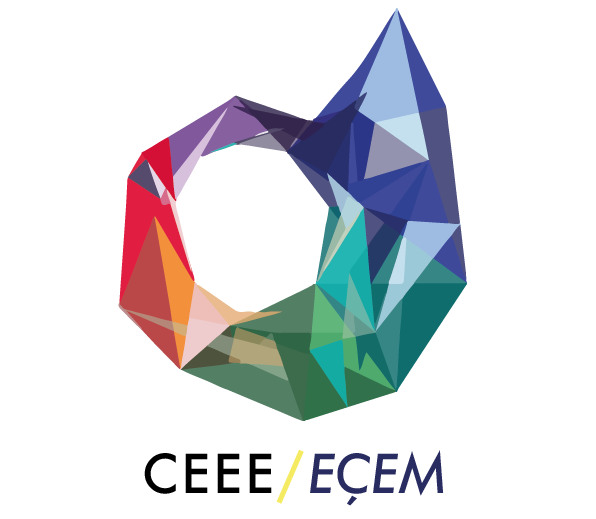Project Starting – Ending Dates: 15/05/2015 – 15/11/2017
Project Budget: TÜBİTAK Contribution: 295.000,00 TL.
METU Budget: 295.000,00 TL. (OzU CEEE students included)
Project Team: PI: Tuba Okutucu Özyurt, Co-PI: M. Pınar Mengüç, Azadeh Didari, Elif Begüm Elçioğlu
Project Partners: Turkey: Middle East Technical University (METU), Özyeğin University, CEEE

REASON
Heat transfer, and especially radiative heat transfer, is one of the four research foci at CEEE. Radiative heat transfer constitutes the basis of many applications, from the Sun’s warming of the planet, to forest fires, from optical measurement systems to nanotechnologies. It is complex and yet a very rich area of study; consideration of radiation energy exchangebased spectrum (wavelength), direction, polarization, and proximity enable us to carry out very innovative studies and contribute to the concept of energy efficiency in fundamental ways. For these reasons, CEEE has always placed significant effort on the study of both the far and nearfield radiation heat transfer studies. These studies have been published as scientific research articles in journals and in conferences and granted patents. M. Pınar Mengüç was a coauthor of the book Thermal Radiation Heat Transfer, the bestknown book on radiative heat transfer in the World. Its 5th edition appeared in 2010, and the 6th edition in 2016, together with John R. Howell and Robert Siegel; recently in January 2021 the 7th edition was published with the participation of Kyle Daun. On the other hand, Mengüç is one of three EditorsinChief of the Journal of Quantitative Spectroscopy and Radiative Transfer (JQSRT) since 2006, which is one of the most prestigious journals in the World on radiation heat transfer and electromagnetic light scattering.
Completely different physical concepts are required to understand radiative heat transfer at very small dimensions (when the distance between two objects is down to the nanometer levels). These nearfield studies have been carried out in house, as well as in partnerships with Sabancı University (SU), Boğaziçi University (BU), Middle East Technical University (METU).

These joint ventures were part of the socalled Istanbul Collaborative (IC), a bottomup research endeavor established initially by Mengüç, Kürşat Şendur (SU) and Ali Koşar (SU). Later Hakan Ertürk (BU) and Tuba Okutucu Özyurt (METU; now ITU). Details of Istanbul Collaborative are outlined on the page 180 of this book.
Other innovative studies required for energy transformation have been carried out together with the CEEE researchers and many collaborators. Among them we should mention the EUFP7 BRICKER Project, which was carried out together with CEEE, Aydın Adnan Menderes University (ADU) Engineering faculty members and Onur Energy Inc. In this project the goal was to modify ADU Medical School Building to make it one of the most energy efficient buildings in the country. To this end, we established a large solar collector plant to generate both electricity and heat from the sun. Another application of radiative heat transfer was to develop tools is to provide thermal and visual comfort in buildings. These application studies were also carried out on Özyeğin University campus.
METHODOLOGIES
CEEE researchers have developed several concepts and algorithms using far and nearfield radiative transfer concepts for many different research areas, both numerically and experimentally. The titles and the faculty members who contributed to the studies are listed below:
- Nearfield radiative transfer predictions betwe en parallel plates (OzU: Azadeh Didari, MPM)
- Nearfield radiative transfer experiments between parallel plates (OzU: MPM; METU; Tuba Okutucu Özyurt; BU: Hakan Ertürk)
- AFMtip based. nanopatterning modeling (OzU: MPM, Vincent Loke; BU: Hakan Ertürk)
- Design of layered thin films for radiative coo ling applications (OzU: MPM; SU: Kürşat Şendur, Ali Koşar; BU: Hakan Ertürk)
- Enhancement of heat transfer with the use na noparticles (OzU: MPM; SU: Kürşat Şendur, Ali Koşar)
- Monte Carlo methods for modeling radiative transfer in industrial furnaces. (OzU: Altuğ Başol, Özgür Ertunç, MPM)
- Application of radiative transfer to buildin gs from architectural point of view (OzU: MPM, Altuğ Başol, Nil Kutlar).
- Application of radiative transfer to concent rating solar power plants (OzU: MPM; ADU: Yunus Çengel, Yunus Çerçi, Atilla Dönük, Selman Sağlam; Onur Energy: Onur Günduru)

During the last 10 plus years, several research grants have been received and completed by the CEEE researchers to carry out these efforts. The very first project was based on the EUFP7Marie Curie Action grant to M. P. Mengüç; it was also supported by a separate TUBITAK project, which was the first TUBITAK grant received at Özyeğin University. Later, there was a second Project jointly conducted with METU.
- AB FP7PEOPLEIRG2008 Marie Curie Actions—International Reintegration Grants (IRG): “NFRAD: NearField Radiation Absorption and Scattering by Nanoparticles on Surfaces”, May 2009 – April 2012.
- TÜBİTAK 1001: NearField Radiation Absorption and Scattering by Nanoparticles on Surfaces”, November 2009 October 2012.
- TÜBİTAK 1001: “NearField Radiation Transfer Experiments for Thermophotovoltaic Energy Harvesting Devices”, Project No: 214M308, PI: Tuba Okutucu Özyurt (METU), coPI: Prof. M. Pınar Mengüç; May 2015 – November 2018.
Other CEEE projects related to Radiative Heat Transfer were as follows:
- EUFP7BRICKER, EU 7th Framework Programme, “Total Renovation Strategies for Energy Reduction in Public Building Stock”, With ACCIONA, Spain, Özyeğin University, October 2013 – June 2019
- BoschSiemens Turkey: ‘New Refrigeration Systems,’ coPI’s: A. Kosar, K. Sendur (Sabancı University), MPM (Özyeğin University), May 2012 – May 2014.
- BoschSiemens Turkey: ‘‘Sustainable Energy Solutions for Cerkezkoy Campus,’’ PI’s: MPM ve Rıfat Öcal (OzU) A. Kosar, K. Sendur (Sabancı University), MPM (Özyeğin University), JanuaryDecember 2013.
IMPLEMENTATION
Our efforts on nanoscale sciences and nano technologies have been geared towards development of new sensors, nanopatterning and energy harvesting methods. In the success of these studies the impact of Istanbul Collaborative (IC) researchers needs to be emphasized.
One of the application areas of farfield radiative heat transfer research is glass process furnaces. These studies spearheaded by Altuğ Başol and supported by a TUBITAK 3501 project with application to ŞişeCam. Ersin Yıldız was among the PhD students who took part in these studies, and Faizan Siddiqui, Gönenç Can Altun and Kaan Menekşedağ were the other graduate students. Two additional TUBITAK 2244 projects led by Ozgur Ertunc and Altug Basol focus also on the radiation heat transfer in high temperature applications such as aircraft combustors and glass melting furnaces Tolga Altunoluk and Berkay Halvaşı are the PhD students who were involved in these studies.
Pinar Mengüç has been working with all these researchers.
In line with the application of these studies, Solar PV panels were placed on 5 of Özyeğin University campus buildings (with the work of MS student Burak Sefer). In addition, in order to improve Aydın Adnan Menderes University Faculty of Medicine, a concentrated solar energy system in the size of a football field was installed in the ADU campus. This system, implemented within the scope of the BRICKER Project, was created by the work of Adnan Menderes University faculty members Yunus Çengel, Yunus Çerçi, Atilla Dönük, Selman Sağlam, Onur Günduru from Onur Enerji, CEEE former employee Yasemin Somuncu and CEEE PhD student Haydar Mohammad.
The importance of light and radiation distribution in buildings has been studied by several CEEE researchers, including Altuğ Başol, Nil Kutlar, Ali Can Yelekci, Cem Keskin, Güven Fidan, Doğa Gizem Memiş.
IMPACT
CEEE’s studies on radiative heat transfer contributed to the research environment in Turkey and beyond.
In this context, numerical algorithms developed for furnaces (Altuğ Başol, Özgür Ertunç, Ersin Yıldız, Faizan Siddiqui, Tolga Altınoluk, Berkay Halvaşı, Gönenç Can Altun, Kaan Menekşedağ) are to be used in several industrial settings, including ŞişeCam and TEI. These studies have been supported by two TÜBİTAK 2244 projects run by Altuğ Başol and Özgür Ertunç.
A number of CEEE researchers or collaborators have worked on nanoscale studies. The areas and the researchers are:
- Energy Harvesting at nanoscales (Azadeh Didari, Elif Begüm Elçioğlu, Tuba Okutucu Özyurt, Hakan Ertürk, Kurt Webb, Zafer Artvin),
- Atomicforce microscopybased nanoscale patterning for nanomachining ( Vincent Loke, Hakan Ertürk, Sina Talebi Moghaddam, Dilan Avşar, Zahra Fathi),
- Nanoscale sensors and systems for radiative cooling applications (Kürşat Şendur, Ali Koşar, Azadeh Didari, Hakan Ertürk, Farhad Kazemi, Muhammed Ali Keçebaş, Erdem Öğüt).
Moreover, radiative heat transfer was studied in several other diverse applications, from cooling of buildings (Roxana Family, Serdar Çelik, Özgür Bayer) to solar shading and the development of architectural concepts (Ali Can Yelekçi, Cem Keskin, Nil Kutlar) as well energy production (Layth AlGebory, Haydar Mohammad, Burak Sefer). Several international and national collaborators have also helped to the efforts by the CEEE researchers.
The nanoscale studies conducted at CEEE also involved many of the Istanbul Collaborative (see page 180) researchers. They have resulted in 34 peerreviewed journal articles so far. In addition, dozens of keynote, invited, and conference presentations were made, and the research experiences we gained was transferred to the society at large. During these 10 plus years, 8 PhD students (OzU: Azadeh Didari, Roxana Family, Layth AlGebory, Haydar Mohammad;
BU: Farhad Kazemi; METU: Begüm Elçioğlu, SU: (as a thesis jury: Erdem Öğüt, Muhammed Ali Keçebaş) have completed their studies on radiative heat transfer related areas. In addition, 9 MS students (OzU: Güven Fidan, Burak Sefer, Ruşen Acet, Zahra Fath; Faizan Pervez Siddiqui; BU: Kurt Webb, Sina Moghaddam Talebi, Dilan Avşar; METU: Nazlı Dönmezer, Zafer Artvin) have worked on radiation transfer related to projects with the contributions of Mengüç. All these students continue their careers and contribute to the society in different ways.
We should also mention the financial impact of the radiative heat transfer research. Concentrated solar energy systems installed by CEEE for Adnan Menderes University (ADU) Faculty of Medicine constitute a part of ADU’s energy efficiency studies, as explained on the BRICKER Project pages. If the entire work is fully implemented, it is predicted that ADU energy bills will decrease to approximately 500,000 Euros per year and it is expected to compensate its cost in 23 years.
The most wellknown globalscale conference series which is devoted to radiative heat transfer is the International Radiation Heat Transfer Symposia. Mengüç started this series back in 1995 and chaired it five times: 1995 (Kuşadası), 1997 (Kuşadası), 2001 (Antalya), 2004 (Istanbul) and 2007 (Bodrum) (the last three symposia co chaired together with Nevin Selçuk). He is part of the Scientific and Organization committees of the later symposia organized in 2010 (Antalya), 2013 (Kuşadası), 2016 (Kapodokya), and 2019 (Athens). The 2010 (Antalya) Symposium was dedicated to Mengüç (along with Jean Taine and Nevin Selçuk).
In addition to the International Radiation Symposia, Mengüç has been involved in the scientific and organizational committees of the Electromagnetic Light Scattering (ELS) Conferences, NanoMicroScale Radiation Transfer Workshops and Eurotherm Radiation Transfer Meetings since 2009. During the last 11 years, he has made many (14) presentations at these conferences either by invitation (8) or with his students.
All information about the studies on Radiative Heat Transfer and the book “Thermal Radiation Heat Transfer” are published on the following portal: thermalradiation.net



